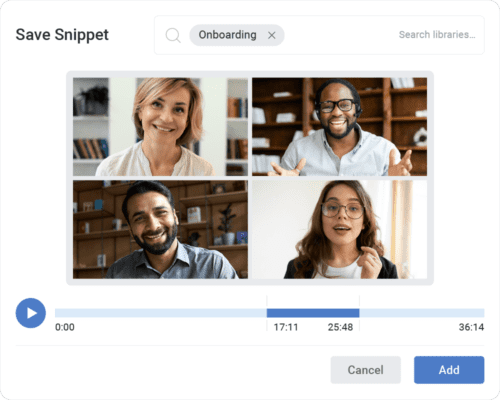What drives your sales readiness strategy? Assumptions? Hunches? Numbers?
Data reveals a lot, but it’s only part of the story. What if you could use real-life customer conversations to inform selling decisions? Conversation intelligence makes this possible by using data from reps’ customer interactions to improve performance.
Continue reading to learn more about what conversation intelligence is, and why it should be an essential piece of your sales readiness program.

Common challenges with sales calls
While handling sales calls is one of the most common responsibilities of a seller’s job, they are inherently unpredictable and can become derailed quickly — a reality that is even more common in a remote work environment. When meeting in person, it’s easier for reps to build rapport and keep things on track. On a video call, or even worse, on the phone, it’s hard to gauge how a buyer is feeling and respond accordingly to continue moving in the right direction.
After reviewing notes, ensuring audio/video is working properly, and clearing video backgrounds of distractions, sellers have a lot to juggle during remote sales meetings. They’ve got to deliver product and solution messaging clearly and effectively; actively listen to the buyer’s questions, concerns, and hesitations; and jot down action items.


Call tracking solutions were introduced to help sellers overcome some of these challenges by enabling them to easily record calls to collect data about the length and number of calls. But, to get actionable data, sales teams need more.
Conversation intelligence goes beyond deal insights
Conversation intelligence takes call tracking not one, but several layers deeper. While it can help identify risks and challenges within specific deals by enabling you to access voice of customer insights, it can also help you go beyond what happened to actionably fix things through built-in sales training programs and sales content management.
Like call tracking, conversation intelligence solutions record calls, but they also transcribe them so reps don’t have to take notes during meetings or go back to listen to recordings. With the added power of AI, conversation intelligence tracks additional information, such as customer sentiment and keywords, for more specific analysis. You can also integrate conversation intelligence with your sales content management system. As you do so, AI can suggest content reps might want to use before and after key meetings based on the call and account history.
What conversation intelligence can measure
So, what specific metrics can conversation intelligence assess? When set up properly, a conversation intelligence platform gathers the following data for every rep call:
- Talk ratio (talking vs. listening)
- Questions asked
- Questions received
- Longest monologue (buyer or seller)
- Use of filler words
- Keyword mentions
- Sentiment
As an example, keyword mentions could include tracking themes around competitor names, product names, and marketing messaging — for AI to flag. For instance, if you want sellers to discuss a new product with buyers, the name of this product can be set as a keyword. After a call, you can go back and see whether the product was mentioned and, if so, how many times. On the reverse side, you can create a set of words that you don’t want salespeople to mention.


Finally, conversation intelligence technology uses certain terms (e.g., “I will send,” “as a next step”) to create a list of action items following the call, reducing the chance for something falling through the cracks and halting a deal.
Turning call insights into action
Analyzing data pulled from your conversation intelligence platform will tell you which reps on your team are having success and highlight the behaviors they practice during sales calls. But simply having this information isn’t enough. While conversation intelligence automates much of the call analysis process and can provide recommendations, sales leaders can also dive deeper into the context of specific calls to drive better decision-making.
For instance, they can look at the call summaries of top sellers. How are they addressing objections and frequently asked questions? What products and features are they focused on? When competitors come up, what do they share with buyers?
By pinpointing these winning behaviors, sales leaders can share snippets and best-of call playlists with their team. They can also more effectively benchmark performance and use data from real calls to inform one-to-one coaching sessions.


It’s important to keep in mind that best practices will depend on the rep’s particular role on the team and the context of the conversation. A business development rep on a discovery call will ask questions and listen, while a sales engineer performing a demo will lead much of the conversation from the front. For this reason, you’ll likely end up with several best practices that apply to different teams, individuals, and call types.
While you can identify top seller behaviors, you can also spot where lower performers may need help. For instance, AI can flag that when some reps speak about pricing, buyers start to get lost by asking lots of follow-up questions, speaking hesitantly, or mentioning objections. This should raise a red flag that the rep needs some additional coaching around your pricing model.


Altogether, the use cases outlined above contribute to an impactful sales readiness program. Identifying best practices and knowledge gaps by using calls from top sellers will enable you to build an onboarding and ongoing coaching strategy based on real-life buyer interactions.







